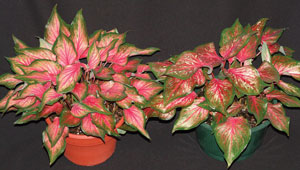12/27/2010
Turning Over a New (Caladium) Leaf
Chris Beytes
What I saw was the world’s largest collection of new caladium breeding. Bob led us through thousands of seedlings from which he and his staff, along with ABBOTT IPCO owner Harry Hollander (who founded Classic with Bob in 2000), would select future introductions. The plants were vigorous, the colors were vivid, and some of the patterns and shades were unlike anything ever seen on a caladium leaf.
“Nothing on this farm has come traditionally,” Bob explains. “It all began as tissue culture, cloned stock or true seed.”
And that’s the story of Classic: a company that was founded for the purpose of bringing caladiums into the 21st century.
It starts in the lab
Tissue culture is Bob’s forte. In fact, he was the first to clone a caladium, while still a PhD student at the University of Florida. After stints with PanAmerican Plant and his own TC firm, Hartman Labs (where he also consulted for Yoder Brothers), Bob served as president of Twyford. That’s where he was when he was approached by Harry Hollander about running caladiums through Twyford’s lab to clean them up. Harry has long been a Dutch bulb importer. But he was selling caladiums, too, and could move containers of them—when he could get them. The supply, however, was undependable, due to aging stock, weather extremes and traditional production methods.
Harry felt the market for caladiums was bigger than the supply allowed. His goal was finding a reliable supply. So he approached Bob, who coincidentally had just started doing cloning of caladiums for another firm that was interested in getting into the business.
“That began the conversation that eventually led to a business proposition,” Bob recalls, “where we would make a case for alternative production, clean stock, selecting clones, breeding, and everything I ever learned at Ball, Yoder and Twyford about inventory management and other administrative tasks.”
That business proposition became Classic Caladiums, launched in 2000 in the sandy fields of Central Florida (the other producers are a bit further south, in the muck soils of Lake Placid).
Classic boasts state-of-the-art processing facilities to complement their new hybrids and tissue-culture upgrading of old standbys. They’re now the world’s second-largest producer, they claim, with 300 acres of caladium production (a combination of in-house and contract
production).
 Pictured: A good example of what cloning can do for an old variety: Both of these are Pink Gem. The plant on the left has been through the cloning process, bringing back its original color and vigor.
Pictured: A good example of what cloning can do for an old variety: Both of these are Pink Gem. The plant on the left has been through the cloning process, bringing back its original color and vigor.
Teaching old clones new tricks
You have to realize that some caladium varieties are 100 years old or more. The popular variety Candidum, for instance, dates back to the 1860s … and is still in the market. Unfortunately, the years have not been kind to Candidum, Bob explains.
“For 150 years, it’s been cut up and replanted, cut up and replanted,” he says. “You know what would happen to potatoes, citrus, mums or any other plant if you did that? They’re invaded by pathogens, they age physiologically.”
Putting an old variety such as Candidum through a tissue culture cloning process can “rejuvenate” it, improving it in every way—branching, color, vigor, stem count, less temperature sensitivity … . Says Bob, “they’re just stronger, they’re new babes. They’re not loaded up with 150 years of history.”
All the historical varieties on Classic’s list have been run through this process, and are recertified regularly to keep them fresh and vigorous.
New breeding
Classic also specializes in developing all-new genetics with a focus in two areas: “copying” existing varieties that are popular but trouble-plagued; and developing all-new colors, patterns and habits.
In the first instance, consider Rosebud: a beautiful variety that happens to be terrible in production due to its pythium sensitivity. Bob says no grower makes money from Rosebud because its yields are “always in the toilet.” And yet it’s always in demand.
Bob’s improvement is called Roseglow, which is less pythium sensitive than Rosebud, while sharing its pretty look (he’s still breeding for more disease resistance).
In new colors and patterns, Classic has many in production, such as Peppermint (pink with white main veins), Raspberry Moon (chartreuse background with dark green mottling and large shiny raspberry-red blotches), Starburst (shocking pink main veins and background with a light green margin that has dark green blotches), Candyland (white lance-leaf [strap] variety with pink spots and pink or white main veins that works with all pot sizes and can take full sun), and Mount Everest (tall white lance-leaf [strap] variety with pink to red main veins suitable for full-sun landscapes). Many more are on the way.
The biggest challenge, Bob says, is when a color doesn’t fit into the traditional red, white or pink category. “What if it’s orange, like Twist n’ Shout?” he asks. “What if it has three colors?” Some industry folks don’t quite know how to categorize them. But he admits, “That’s a wonderful problem! And a wonderful opportunity.”
The current crop of caladium growers in Central Florida, which Bob says has shrunk to probably a dozen producers, are, for the most part, much more aware of the importance of fresh, clean stock and quality control than were their predecessors. Bob hopes Classic’s improvements to the crop will raise the awareness and appreciation for caladiums in general—which he calls “a really cool plant”—thereby helping everyone sell more. He’s even talking about marketing Classic’s varieties to other caladium producers. Why? To raise the standard of all caladiums on the market, and because he thinks there’s plenty of market to go around.
Says Bob, “I personally believe that the market for caladiums is 10 times what’s currently being addressed.”
GT
Photos courtesy of Classic Caladiums

